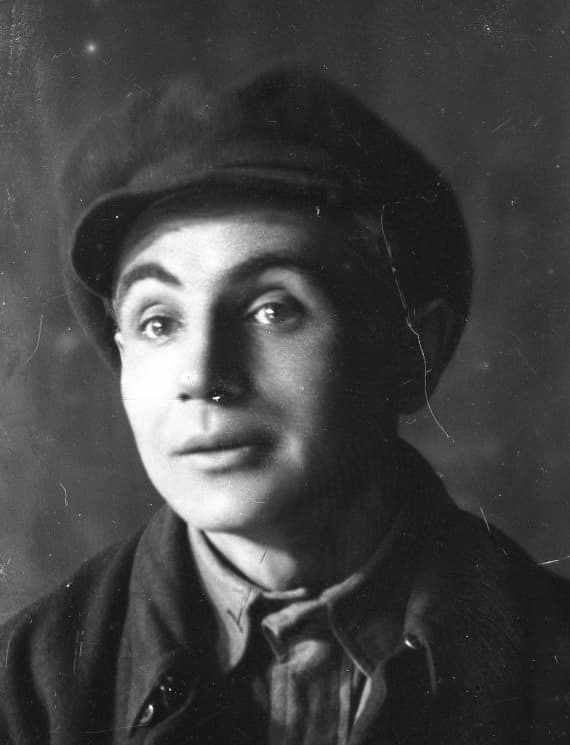Dramatic etudes by Oleksandr Oles
Premier: November 17, 1917
Directors : Les Kurbas, Hnat Yura
Artist : Anatol Petrytskyi
Directed by Les Kurbas:
Autumn
Young Lady – Vira Onatska
Gentleman – Les Kurbas
Guard – Antonina Smereka
The Dance of Life
First Brother – Yona Shevchenko
Second Brother – Marko Tereshchenko
Third Brother – Stepan Bondarchuk
Fourth Brother – Ivan Levchenko
Sister – Sofiia Manuilovych
Father – Oleksii Vatulia, Vasyl Vasylko
By the Light of the Bonfire
Mariia – Polina Samiilenko, Nadiia Repnina
Halia – Olimpiia Dobrovolska
Davyd – Les Kurbas, Volodymyr Leontovych
Andrii – Valerii Vasyliev
Directed by Hnat Yura:
Quiet Evening
He – Hnat Yura
She – Ryta Neshchadymenko, Antonina Smereka
Les Kurbas’s Theater of O. Oles, based on the dramatic etudes of Oleksandr Oles, opened at the Young Theater on November 17, 1917. The show was an attempt to study and explore the nature and aesthetics of Symbolist theater.
Les Kurbas always set bold new goals and tasks for himself and his team. By creating a show based on the works of the subtle lyricist and Symbolist Oleksandr Oles, the director sought to immerse himself in the inner life of man, plunge into his subconscious, into the realm of the secret depths of his soul. For the theater’s young actors this was a new and interesting yet difficult task. It was equally difficult for the audience. The reviews in the press were mostly warm, but the audience response was sometimes cold.
Actor Vasyl Vasylko recalled that the play wasn’t a great success. He gave Kurbas’s work two very different assessments: “I was struck by the theater’s failure, but this was a defeat that was deserving much fortune.” The word “defeat” didn’t appear at all in the recollections of other Young Theater members and critics. The actors had a hard time mastering the new artistic language, but this play was a good school for learning the aesthetics of Symbolist theater and improving their professional skills.
While working on the play, Les Kurbas realized that not all spectators were ready for such theater. Anticipating risks and wanting to educate a thoughtful audience, the director added a prologue. He understood that art doesn’t need to be explained, but in this show the prologue was fundamental. At the premier, before the start of the performance, Kurbas went out to the audience dressed as a Pierrot and told them about Symbolist theater. He said: “While every play is a holiday for the actor, today is a special holiday for us, today is our first attempt at a new field, at the theater of Oles. It is new not only for us but also for most of you, dear citizens, because Oles’s theater is theater for the chosen, and you don’t get to see if often.”
As expected, not everyone liked the idea of a prologue. Some said that the introductory speech should have been a separate lecture or newspaper article because Kurbas didn’t say anything new for a prepared audience, but for an unprepared audience the prologue was oversaturated with “categorical imperatives and other philosophical terms they didn’t know.” The director was advised to appear on stage (if he so desires) in a “costume of less dubious originality.” Theater critic and historian Dmytro Antonovych wrote that Kurbas’s speech was more a “long, dry, pedantic lecture” than a prologue.
Kurbas’s prologue, as was already mentioned, wasn’t well-received by critics, but the play itself received rave reviews. Journalist Andrii Nikovskyi wrote that the experience of the Young Theater in staging Ole’s texts can be seen as an experiment by young seekers who have the beginnings of artistic interpretation of Oles’s writing, but on November 17 they hadn’t discovered anything more. “But actually, jumping from Vynnychenko’s everyday characters, snatched from the vortex of life, immediately to Oles’s subtle poetic figures is a rather risky experiment.” Antonovych, on the contrary, wrote that with this play the theater made “another high achievement.” Writer and theater critic Mykola Voronyi stressed that the show based on Ole’s work stood out for its “original directorial thoughts and aesthetic taste.”
Kurbas deliberately took a risk with every new production at the Young Theater. He was creating a new theater, a new actor, a new spectator, and he understood that there wouldn’t be any progress without risks, experiments and search.
The show consisted of three etudes: Autumn, The Dance of Life, and By the Light of the Bonfire. The last etude was later replaced by Quiet Evening in the version directed by Hnat Yura, where he himself played the role of the fiancé. This was his acting and directorial debut with the Young Theater. For actress Ryta Neshchadymenko the role of the fiancé was also her onstage debut at the Young Theater. After two intense etudes directed by Kurbas, Quiet Evening was psychologically easier for the audience, although the story of two people who decide to get married even though they are in love with others was shrouded in notes of sadness.
This was the first time that the young, 22-year-old artist Anatol Petrytskyi worked with the Young Theater. The actors recalled he wrapped the stage in dark cloths and in the depths placed a large snow-covered window, to which he attached a branch that banged on the glass during the play. The scenery changed somewhat for The Dance of Life: instead of a window there was a panel with woven blood-red lines that, according to actor Serhii Bondarchuk, made the audience feel uneasy.
The window worked well in the first etude Autumn – in the finale silhouettes appeared of the Lord and the Guard, as she raises a knife behind his back. Kurbas played the Lord.
Since the show consisted of etudes, they were perceived and reviewed separately. For example, Nikovskyi wrote that Autumn and By the Light of the Bonfire weren’t that good (although the mood was conveyed in Autumn), while Dance of Life went well and made a strong impression on the audience.
The final scene of Dance of Life was especially powerful. According to the plot, all the brothers and the sister have a physical defect (a hump). One of the brothers also has a mental disorder. All of them are anxiously waiting for their father, who is supposed to tell them the news about whether the newborn baby will be a cripple like them or not. The brothers, angry at their lives, at first are veiled and then openly wish that the newborn suffers the same torment that they did. In the end, out of terrifying anticipation they start to dance joyfully as their sister plays the violin. When the father arrives he is struck by what he sees. They stop suddenly and anxiously await the verdict. Upon hearing “cripple” they again start dancing wildly, rejoicing in the terrible news. The father dies from horror. The etude left a very strong and depressing impression on spectators.
Kurbas called Oles’s theater a temple of the human spirit and in this temple gave the opportunity to hear not only the beautiful but the terrifying “secret tremors of the shallow depths” of the soul and subconscious.

